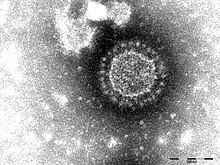| Porcine epidemic diarrhea virus | |
|---|---|

| |
| Porcine epidemic diarrhea virus particles seen by electron microscopy | |
| Virus classification | |
| (unranked): | Virus |
| Realm: | Riboviria |
| Kingdom: | Orthornavirae |
| Phylum: | Pisuviricota |
| Class: | Pisoniviricetes |
| Order: | Nidovirales |
| Family: | Coronaviridae |
| Genus: | Alphacoronavirus |
| Subgenus: | Pedacovirus |
| Species: | Porcine epidemic diarrhea virus
|
Porcine epidemic diarrhea virus (PED virus or PEDV) is a coronavirus that infects the cells lining the small intestine of a pig, causing porcine epidemic diarrhoea, a condition of severe diarrhea and dehydration. Older hogs mostly get sick and lose weight after being infected, whereas newborn piglets usually die within five days of contracting the virus. PEDV cannot be transmitted to humans, nor contaminate the human food supply.
It was first discovered in Europe, but has become increasingly problematic in Asian countries, such as Korea, China, Japan, the Philippines, and Thailand. It has also spread to North America: it was discovered in the United States on May 5, 2013 in Indiana,[1] and in Canada in the winter of 2014. In January 2014, a new variant strain of PEDV with three deletions, one insertion, and several mutations in S (spike) 1 region was identified in Ohio by the Animal Disease Diagnostic Lab of Ohio Department of Agriculture.[2]
PEDV has a substantial economic burden given that it is highly infectious, resulting in significant morbidity and mortality in piglets. Morbidity and mortality rates were lower for vaccinated herds than for nonvaccinated herds, which suggests the emergence of a new PEDV field strain(s) for which the current vaccine, based on the CV777 strain, was partially protective.[3] Consumers are likely to feel the effects of the viral disease in the form of higher prices for pork products.[4]
- ^ Snelson, H. (2014). Comprehensive Discussion of PEDv, Slide 3, American Association of Swine Veterinarians presentation to the 2014 Pork Management Conference, June 19, 2014, http://www.slideshare.net/trufflemedia/dr-harry-snelson-pedv-lessons-learned
- ^ Wang, L.; Byrum, B.; Zhang, Y. (2014). "New Variant of Porcine Epidemic Diarrhea Virus, United States, 2014". Emerging Infectious Diseases. 20 (5): 917–9. doi:10.3201/eid2005.140195. PMC 4012824. PMID 24750580.
- ^ Song, D.; Park, B. (2012). "Porcine epidemic diarrhoea virus: a comprehensive review of molecular epidemiology, diagnosis, and vaccines". Virus Genes. 44 (2): 167–175. doi:10.1007/s11262-012-0713-1. PMC 7089188. PMID 22270324.
- ^ Enoch, D. (29 December 2013). "Deadly pig disease trims supplies, drives pork prices higher". Agri-Pulse. Retrieved 11 January 2014.